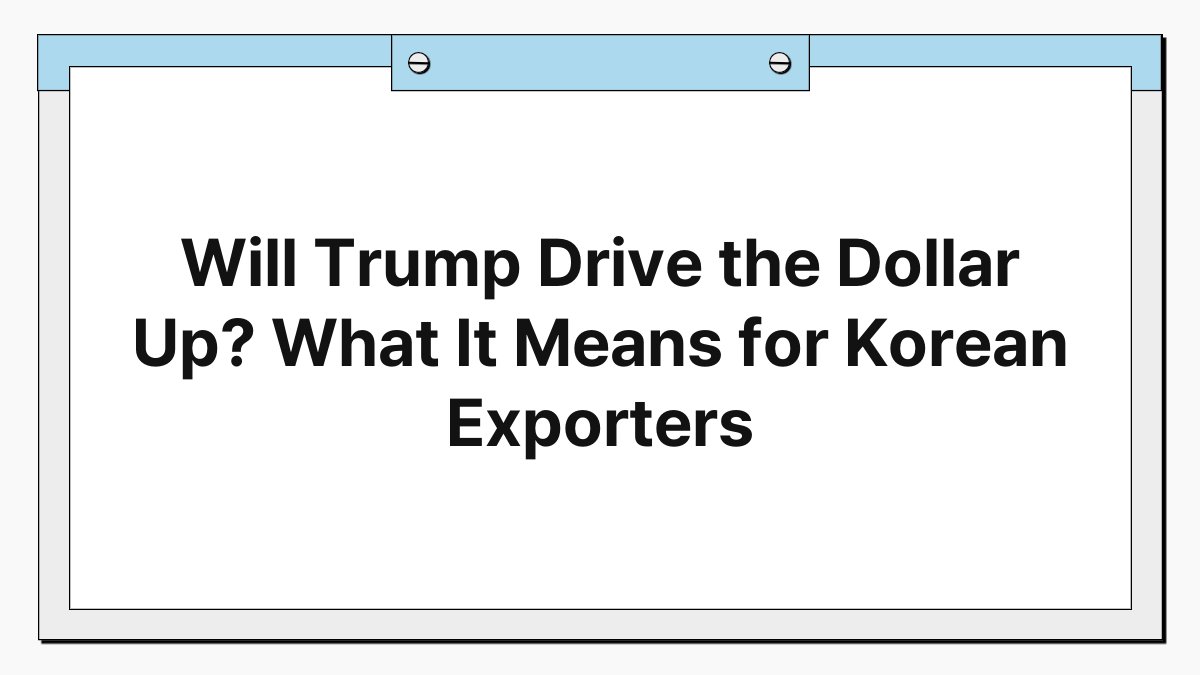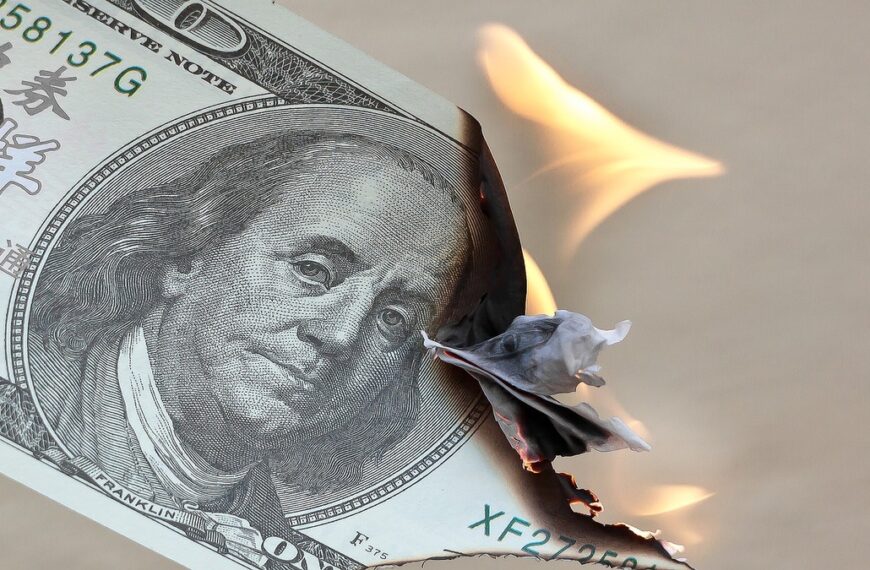[K-Bridge/Samuel] Will Trump Drive the Dollar Up? What It Means for Korean Exporters
This article explores how former U.S. President Donald Trump’s policies could impact the value of the U.S. dollar and what that means for Korean exporters.
An increase in the dollar’s value has broad implications for the global economy and serves as a critical factor for export-driven economies like South Korea.
We will delve into how Trump’s potential policies might influence the dollar and examine the opportunities and challenges that Korean exporters may face as a result.
Through this article, readers will gain insights into how fluctuations in the dollar’s value affect the Korean economy and explore strategic responses Korean businesses can adopt.
The Impact of Trump’s Policies on the Dollar
Understanding Trump’s Economic Policies
Trump’s economic policies have been marked by a focus on protectionism and nationalism.
His administration’s approach to trade included imposing tariffs on various goods, particularly from China.
This protectionist stance aimed to boost domestic manufacturing and create jobs in the U.S. economy.
Such policies can lead to fluctuations in the dollar’s value as they affect international trade balances.
When tariffs are imposed, it can lead to a decrease in imports, potentially strengthening the dollar as demand for domestic goods increases.
The Role of Interest Rates
Interest rates play a crucial role in determining the value of the dollar.
When the Federal Reserve raises interest rates, it typically strengthens the dollar because higher rates offer better returns on investments denominated in dollars.
Trump’s administration saw periods of rate hikes, which were intended to curb inflation and stabilize the economy.
These movements in interest rates can influence foreign investment flows, leading to increased demand for the dollar.
As Korean exporters navigate this landscape, understanding interest rate trends becomes essential for strategic planning.
Market Reactions to Trump’s Leadership
The market’s reaction to Trump’s leadership has been mixed, often influenced by his statements and decisions.
For instance, announcements regarding trade negotiations or changes in fiscal policy can cause immediate fluctuations in the dollar’s value.
Investors closely monitor these developments, as they can impact market confidence and the overall economic outlook.
Korean exporters need to stay informed about these market dynamics to anticipate changes in demand for their products and adjust their strategies accordingly.
The Relationship Between Dollar Strength and Korean Exports
Export Competitiveness
A strong dollar can pose challenges for Korean exporters, as it makes their products more expensive for foreign buyers.
When the dollar appreciates, the cost of Korean goods in international markets rises, potentially leading to decreased demand.
This situation requires exporters to consider pricing strategies and cost management to maintain competitiveness.
In contrast, a weaker dollar can enhance the attractiveness of Korean products abroad, providing a boost to export volumes.
Currency Exchange Rates
Understanding currency exchange rates is vital for Korean exporters.
The value of the won against the dollar directly affects profit margins on exports.
If the dollar strengthens, the won may weaken, providing a cushion for exporters.
However, if the won appreciates against the dollar, it can erode profit margins, leading to difficult decisions regarding pricing and production.
Exporters must employ hedging strategies to mitigate risks associated with currency fluctuations.
Long-term Export Strategies
To navigate the complexities of a fluctuating dollar, Korean exporters should develop long-term strategies that incorporate market analysis and risk management.
Diversifying markets can help reduce reliance on any single currency, spreading risk across different regions.
Additionally, investing in innovation and quality can help maintain demand for Korean products, even in the face of currency challenges.
By focusing on value-added exports, companies can better withstand the pressures of currency fluctuations.
Global Economic Factors Influencing the Dollar
Geopolitical Tensions
Geopolitical tensions can significantly impact the dollar’s value.
Events such as trade wars, military conflicts, or diplomatic disputes can lead to uncertainty in global markets.
Investors often flock to the dollar as a safe haven during turbulent times, driving its value higher.
For Korean exporters, understanding these geopolitical dynamics is crucial for anticipating changes in market conditions and adjusting their strategies accordingly.
Inflation and Economic Growth
Inflation rates and economic growth indicators also play a significant role in determining the dollar’s value.
Higher inflation can prompt the Federal Reserve to raise interest rates, strengthening the dollar.
Conversely, sluggish economic growth can weaken the dollar as confidence in the economy diminishes.
Korean exporters must monitor these economic indicators to make informed decisions regarding production, pricing, and market entry strategies.
Trade Agreements and Tariffs
Trade agreements and tariffs can have immediate effects on the dollar’s strength.
Favorable trade agreements can enhance economic growth and boost the dollar, while tariffs can create friction and lead to a weaker currency.
Korean exporters need to stay abreast of changes in trade policy and agreements to adapt their strategies effectively.
Understanding the implications of these changes can help businesses position themselves advantageously in the global market.
Strategies for Korean Exporters Amid Dollar Fluctuations
Diversification of Markets
To mitigate risks associated with dollar fluctuations, Korean exporters should consider diversifying their markets.
By expanding into regions with different currencies, exporters can reduce their dependence on the dollar and spread their risk.
This strategy can also open up new opportunities for growth in emerging markets where demand for Korean products may be increasing.
Currency Hedging Techniques
Implementing currency hedging techniques can be an effective way for exporters to protect themselves against adverse currency movements.
By using financial instruments such as options and futures contracts, exporters can lock in exchange rates and minimize potential losses.
This proactive approach allows businesses to focus on their core operations without the constant worry of currency fluctuations impacting profitability.
Building Strong Relationships with Buyers
Establishing strong relationships with international buyers can provide Korean exporters with a competitive edge.
By fostering trust and understanding, exporters can negotiate better terms and conditions, which can be particularly beneficial during times of currency volatility.
Additionally, strong relationships can lead to increased loyalty and repeat business, helping to stabilize revenue streams.
The Future of the Dollar and Its Implications for Korean Exporters
Anticipating Economic Shifts
As global economic conditions evolve, Korean exporters must be prepared to anticipate shifts that may affect the dollar’s value.
Monitoring economic indicators, geopolitical developments, and trade policies will be essential for staying ahead of potential changes.
By being proactive, exporters can position themselves to take advantage of favorable conditions while mitigating risks associated with adverse developments.
Embracing Technological Advancements
Technological advancements can play a significant role in helping Korean exporters navigate the challenges posed by currency fluctuations.
By leveraging digital tools for market analysis, supply chain management, and customer engagement, businesses can enhance their agility and responsiveness.
Embracing innovation can lead to improved efficiency and competitiveness in the global market.
Focusing on Sustainability
Sustainability is becoming increasingly important in global trade, and Korean exporters should consider incorporating sustainable practices into their operations.
By prioritizing environmentally friendly practices, companies can appeal to a growing segment of consumers who value sustainability.
This focus can enhance brand reputation and open up new markets, providing additional avenues for growth even amidst currency fluctuations.
Conclusion: Navigating the Future Landscape
In conclusion, the question of whether Trump will drive the dollar up holds significant implications for Korean exporters.
Understanding the interplay between Trump’s policies, global economic factors, and currency dynamics is crucial for developing effective strategies.
By diversifying markets, implementing currency hedging techniques, and embracing innovation, Korean exporters can navigate the challenges and seize opportunities presented by fluctuations in the dollar’s value.
As the global landscape continues to evolve, staying informed and adaptable will be key to sustaining competitiveness in the international market.








